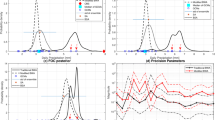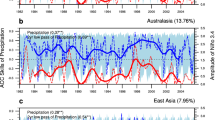Abstract
The accuracy of climate projections is improved by increasing the number of samples from ensemble experiments, leading to a decrease in the confidence interval of a target climatological variable. The improvement in the accuracy depends on the degree of independence of each ensemble member in the experiments. When the members of ensemble experiments are dependent on each other, the introduction of an effective sample size (ESS) is necessary to correctly estimate the confidence interval. This study is the first attempt to estimate the ESS for precipitation as a function of the number of ensemble members, although some previous studies have investigated another type of ESS in terms of the length of simulation period. The ESS in the present study is intrinsic to the atmospheric general circulation models (AGCM) forced by the ocean boundary condition because the outputs of AGCM ensemble members are similar or dependent on each other due to the commonly used boundary condition, i.e., the distribution of sea surface temperature, sea ice concentration, and sea ice thickness. Looking at the values of ESS as a function of geographical location, those in the tropics and over the ocean are smaller than those at higher latitudes and over continents; precipitation events in areas with smaller (larger) ESS are strongly (weakly) constrained by the ocean boundary condition. The increase in temporal and spatial averaging scales for precipitation estimation leads to the decrease in the ESS, of whose trend is attributed to the spatio-temporal characteristics of the precipitation events as represented by the power spectrum and co-spectrum.







Similar content being viewed by others
References
Decremer D, Chung CE (2014) Comparison of model noise in AGCM independent ensemble runs and continuous simulation. Asia-Pac J Atmos Sci 50(3):263–270
Decremer D, Chung CE, Räisänen P (2015) Strategies for reducing the climate noise in model simulations: ensemble runs versus a long continuous run. Clim Dyn 44(5-6):1367–1379
Deser C, Phillips A, Bourdette V, Teng H (2012) Uncertainty in climate change projections: the role of internal variability. Clim Dynam 38(3-4):527–546
Fu X, Wang B, Waliser DE, Tao L (2007) Impact of atmosphere-ocean coupling on the predictability of monsoon intraseasonal oscillations*. J Atmos Sci 64(1):157–174
Hibino K, Takayabu I (2016) A trade-off relation between temporal and spatial averaging scales on future precipitation assessment. J Meteor Soc Jpn 94 (0):121–134
Hirahara S, Ishii M, Fukuda Y (2014) Centennial-scale sea surface temperature analysis and its uncertainty. J Clim 27(1):57–75
Hirai M, Sakashita T, Kitagawa H, Tsuyuki T, Hosaka M (2007) Development and validation of a new land surface model for jma’s operational global model using the ceop observation dataset. J Meteorol Soc Jpn Ser II(85):1–24
Hogg RV, Tanis EA (1977) Probability and statistical inference. Macmillan, New York, vol 993
IPCC (2013) Climate change 2013: the physical science basis. Contribution of working group I to the fifth assessment report of the intergovernmental panel on climate change. University Press, Cambridge Cambridge
Killip S, Mahfoud Z, Pearce K (2004) What is an intracluster correlation coefficient? crucial concepts for primary care researchers. Ann Family Med 2(3):204–208
Laurmann JA, Gates WL (1977) Statistical considerations in the evaluation of climatic experiments with atmospheric general circulation models. J Atmos Sci 34(8):1187–1199
Meehl GA, Covey C, Taylor KE, Delworth T, Stouffer RJ, Latif M, McAvaney B, Mitchell JF (2007) The WCRP CMIP3 multimodel dataset: a new era in climate change research. B Am Meteorol Soc 88(9):1383–1394
Mizuta R, Yoshimura H, Murakami H, Matsueda M, Endo H, Ose T, Kamiguchi K, Hosaka M, Sugi M, Yukimoto S et al (2012) Climate simulations using MRI-AGCM3. 2 with 20-km grid. J Meteor Soc Japan 90(0):233–258
Mizuta R, Murata A, Ishii M, Shiogama H, Hibino K, Mori N, Arakawa O, Imada Y, Yoshida K, Aoyagi T et al (2016) Over 5000 years of ensemble future climate simulations by 60 km global and 20 km regional atmospheric models. Bulletin of the American Meteorological Society
Sanderson BM, Wehner M, Knutti R (2017) Skill and independence weighting for multi-model assessments. Geosci Model Dev 10(6):2379–2395
Shinoda M (2001) Climate memory of snow mass as soil moisture over central eurasia. J Geophys Res 106(D24):33,393–33,403
Stern W, Miyakoda K (1995) Feasibility of seasonal forecasts inferred from multiple GCM simulations. J Clim 8(5):1071–1085
Sugi M, Kawamura R, Sato N (1997) A study of SST-forced variability and potential predictability of seasonal mean fields using the JMA global model. J Meteor Soc Jpn 75(3):717–736
Takayabu YN (1994a) Large-scale cloud disturbances associated with equatorial waves. Part I: spectral features of the cloud disturbances. J Meteor Soc Jpn 72:433–448
Takayabu YN (1994b) Large-scale cloud disturbances associated with equatorial waves. Part II: westward-propagating inertio-gravity waves. J Meteor Soc Jpn 72:451–465
Thiébaux HJ, Zwiers FW (1984) The interpretation and estimation of effective sample size. J Appl Meteorol 23(5):800–811
Trenberth KE (1984) Some effects of finite sample size and persistence on meteorological statistics. Part I: autocorrelations. Mon Weather Rev 112 (12):2359–2368
Wang B, Lee JY, Xiang B (2015) Asian summer monsoon rainfall predictability: a predictable mode analysis. Clim Dynam 44(1-2):61–74
Wheeler M, Kiladis GN (1999) Convectively coupled equatorial waves: analysis of clouds and temperature in the wavenumber-frequency domain. J Atmos Sci 56:374–399
Yang X, Vecchi GA, Gudgel RG, Delworth TL, Zhang S, Rosati A, Jia L, Stern WF, Wittenberg AT, Kapnick S et al (2015) Seasonal predictability of extratropical storm tracks in GFDL’s high-resolution climate prediction model. J Clim 28(9):3592–3611
Acknowledgments
This study was supported by Theme C of the SOUSEI and TOUGOU program (JPMXD0717935561) funded by the Ministry of Education, Culture, Sports, Science and Technology of Japan.
Author information
Authors and Affiliations
Corresponding author
Additional information
Publisher’s note
Springer Nature remains neutral with regard to jurisdictional claims in published maps and institutional affiliations.
Electronic supplementary material
Below is the link to the electronic supplementary material.
Rights and permissions
About this article
Cite this article
Hibino, K., Takayabu, I. Effective sample size for precipitation estimation in atmospheric general circulation model ensemble experiments: dependence on temporal and spatial averaging scales. Climatic Change 163, 297–315 (2020). https://doi.org/10.1007/s10584-020-02886-0
Received:
Accepted:
Published:
Issue Date:
DOI: https://doi.org/10.1007/s10584-020-02886-0




